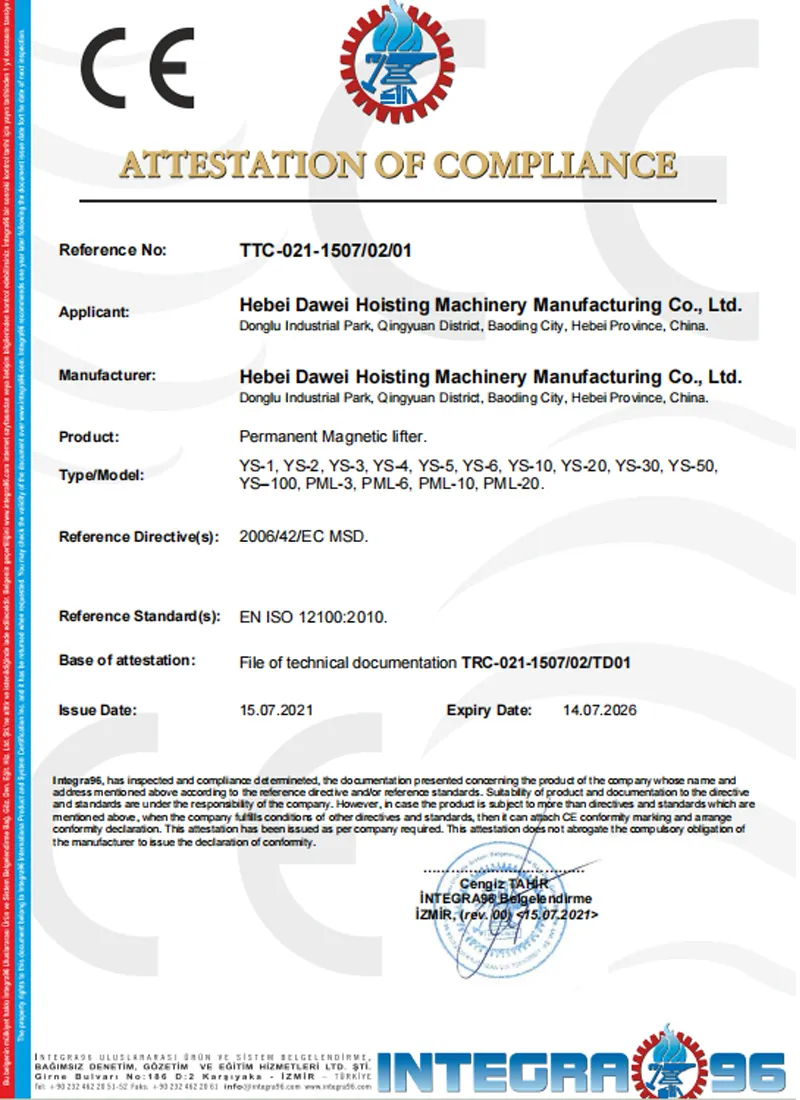gantry hoists
Gantry Hoists An Essential Tool in Material Handling
Gantry hoists are widely recognized for their versatility and efficiency in material handling across various industries. From construction sites to warehouses and manufacturing facilities, these robust pieces of equipment play a crucial role in moving heavy loads safely and effectively. This article delves into the features, advantages, applications, and considerations regarding gantry hoists, highlighting their importance in today's industrial landscape.
What is a Gantry Hoist?
A gantry hoist consists of a hoist mounted on a structure that has vertical supports and horizontal beams, resembling a bridge. This design allows the hoist to traverse in a lateral direction, making it ideal for lifting and moving heavy objects over a wide area without the need for permanent installation. Gantry hoists can be powered manually or electrically, depending on the application and weight requirements.
Key Features
1. Mobility One of the standout features of gantry hoists is their portability. Many models come with wheels, allowing them to be moved easily from one location to another. This mobility enhances productivity by enabling workers to use the hoist where it is needed most.
2. Adjustable Height Gantry hoists typically offer adjustable height settings, allowing users to customize the hoist according to the specific requirements of the job. This adaptability makes them suitable for various tasks, from lifting vehicles to assembling heavy machinery.
3. Load Capacity Gantry hoists are available in a wide range of load capacities, accommodating everything from small equipment to large industrial components. This versatility makes them versatile tools for different industries.
4. Easy Assembly Many gantry hoists are designed for quick assembly and disassembly. This feature is particularly beneficial for projects that require temporary setups, as it minimizes downtime and labor costs.
Advantages of Gantry Hoists
The use of gantry hoists offers several advantages
1. Safety Safety is paramount when handling heavy loads. Gantry hoists are designed with safety features such as sturdy construction, secure lifting mechanisms, and stability, reducing the risk of accidents and injuries.
2. Enhanced Efficiency By streamlining the process of lifting and moving heavy items, gantry hoists enhance overall operational efficiency. This results in faster project completion and improved productivity.
3. Cost-Effective Investing in a gantry hoist can be more cost-effective than traditional lifting methods, especially for businesses that require frequent lifting tasks. Their portability and ease of setup save both time and labor costs, providing a solid return on investment.
4. Minimized Risk of Damage The stability and controlled lifting offered by gantry hoists significantly reduce the risk of damaging the materials being handled. This advantage is particularly important when working with sensitive components or costly equipment.
gantry hoists

Applications in Various Industries
Gantry hoists are used across a wide spectrum of industries, including
1. Construction In construction, gantry hoists are commonly employed to lift heavy materials such as steel beams, concrete panels, and heavy machinery, facilitating on-site assembly and installation.
2. Manufacturing Many manufacturing facilities utilize gantry hoists for assembling machinery, moving large parts, and transporting finished products to shipping areas.
3. Automotive In automotive repair and production, gantry hoists are invaluable for lifting engines, body parts, and other heavy components, streamlining workflows.
4. Aerospace The aerospace industry also benefits from gantry hoists, using them to lift fuselages, engines, and other heavy aircraft components during assembly and maintenance.
Considerations When Choosing a Gantry Hoist
When selecting a gantry hoist, several factors should be considered
1. Load Capacity It is essential to choose a gantry hoist with a load capacity that meets the specific needs of your operations.
2. Height Adjustability Depending on the requirements of your workspace, consider whether the hoist offers the necessary height adjustability.
3. Mobility Needs If the hoist will be frequently moved, opt for models with wheels and a lightweight design.
4. Type of Power Source Consider whether a manual or electric hoist is more suitable for your operations, keeping in mind the workload and frequency of use.
Conclusion
In conclusion, gantry hoists are indispensable tools in the material handling sector, offering mobility, safety, and efficiency in moving heavy loads. With various applications spanning multiple industries, the versatility of gantry hoists continues to make them a preferred choice for many businesses. Understanding their features and benefits can help companies maximize productivity while ensuring the safety of their workforce.
-
The Power of Trolley Cargo and Machinery Moving SolutionsNewsAug.22,2025
-
Exploring Magnetic Lifting Devices for Efficient Steel Plate HandlingNewsAug.22,2025
-
The Essential Guide to Portal CraneNewsAug.22,2025
-
Enhancing Efficiency in Permanent Magnetic LiftersNewsAug.22,2025
-
Heavy-Duty Machinery Movers and Material Handling SolutionsNewsAug.22,2025
-
The Comprehensive Guide to Adjustable Gantry CranesNewsAug.22,2025
-
The Ultimate Guide to Heavy Machinery Moving EquipmentNewsAug.04,2025
